

50 Years Ago, This Was a Wasteland. He Changed Everything. Nearly Half of the U.S. Is in Drought. It May Get Worse. Nearly half of the continental United States is gripped by drought, government forecasters said Thursday, and conditions are expected to worsen this winter across much of the Southwest and South.
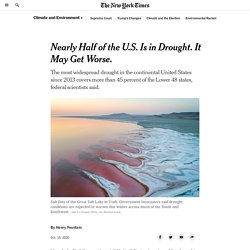
Mike Halpert, deputy director of the Climate Prediction Center, a part of the National Oceanic and Atmospheric Administration, said a lack of late-summer rain in the Southwest had expanded “extreme and exceptional” dry conditions from West Texas into Colorado and Utah, “with significant drought also prevailing westward through Nevada, Northern California and the Pacific Northwest.” Aquifers and Groundwater. • Water Science School HOME • Groundwater topics • Groundwater and aquifers A hole dug at the beach is a great way to illustrate the concept of how, below a certain depth, the ground, if it is permeable enough to hold water, is saturated with water.

The upper surface of this zone of saturation is called the water table. Credit: Howard Perlman, USGS I hope you appreciate my spending an hour in the blazing sun to dig this hole at the beach. Groundwater is one of our most valuable resources—even though you probably never see it or even realize it is there. When a water-bearing rock readily transmits water to wells and springs, it is called an aquifer. Untitled. In India, there's water everywhere, and nowhere.
(1) PUMPED DRY: The Global Crisis of Vanishing Groundwater-FULL VIDEO. U.S. faces fresh water shortages due to climate change, research says. NEW YORK (Thomson Reuters Foundation) - The pressures of climate change and population growth could cause water shortages in most of the United States, preliminary government-backed research said on Thursday.
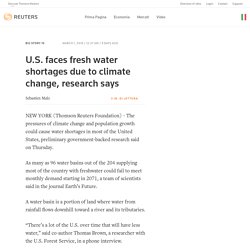
As many as 96 water basins out of the 204 supplying most of the country with freshwater could fail to meet monthly demand starting in 2071, a team of scientists said in the journal Earth’s Future. A water basin is a portion of land where water from rainfall flows downhill toward a river and its tributaries. “There’s a lot of the U.S. over time that will have less water,” said co-author Thomas Brown, a researcher with the U.S. Forest Service, in a phone interview. “We’ll be seeing some changes.” Scientists warn of climate 'time bomb' for world's groundwater. Future generations face an environmental "time bomb" as the world's groundwater systems take decades to respond to the present day impact of climate change, scientists warned on Monday.
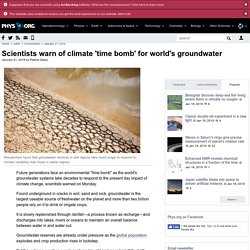
Found underground in cracks in soil, sand and rock, groundwater is the largest useable source of freshwater on the planet and more than two billion people rely on it to drink or irrigate crops. It is slowly replenished through rainfall—a process known as recharge—and discharges into lakes, rivers or oceans to maintain an overall balance between water in and water out. Groundwater reserves are already under pressure as the global population explodes and crop production rises in lockstep.
But the extreme weather events such as drought and record rainfall—both made worse by our heating planet—could have another long-lasting impact on how quickly reserves replenish, according to a study published in Nature Climate Change. 'Massive lags' The future of water: How we will stop wasting water—and make more of it. 40 million Americans depend on the Colorado River. It’s drying up. Prompted by years of drought and mismanagement, a series of urgent multi-state meetings are currently underway in Las Vegas to renegotiate the use of the Colorado River.
Seven states and the federal government are close to a deal, with a powerful group of farmers in Arizona being the lone holdouts. The stakes are almost impossibly high: The Colorado River provides water to 1-in-8 Americans, and irrigates 15 percent of the country’s agricultural products. The nearly 40 million people who depend on it live in cities from Los Angeles to Denver. The river supports native nations and industry across the vast desert Southwest — including 90 percent of U.S. -grown winter vegetables. Decades of warming temperatures have finally forced a confrontation with an inescapable truth: There’s no longer enough water to go around. Since then, the news has only gotten worse. Deluge & Drought: Water Security in a Changing Climate. Water is essential for life.
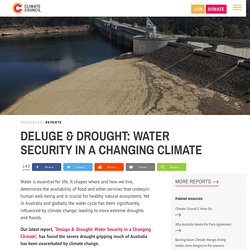
It shapes where and how we live, determines the availability of food and other services that underpin human well-being and is crucial for healthy natural ecosystems. Yet in Australia and globally the water cycle has been significantly influenced by climate change, leading to more extreme droughts and floods. Our latest report, “Deluge & Drought: Water Security in a Changing Climate”, has found the severe drought gripping much of Australia has been exacerbated by climate change. Australia’s water security has already been significantly influenced by climate change. Rainfall patterns are shifting and the severity of floods and droughts has increased.
Warragamba Dam in NSW is currently at 64.9%. The severe drought being experienced across Queensland, NSW and northern Victoria is being influenced by climate change. Phoenix-area golf courses use more water than anywhere else in U.S. CNN: Most Bottled Water is Tap. Tapped Documentary- Effects of Bottled Water. Tapped Out: A documentary about water. Flow: For Love of Water (Full Documentary)
"Flow" Trailer (Who owns the worlds water supply!?) Groundwater Depletion Stresses Majority of World’s Largest Aquifers. Scientists do not know how much groundwater is left.
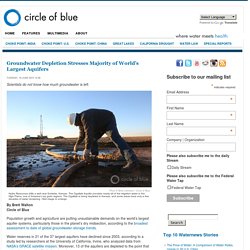
Photo © Brian Lehmann / Circle of Blue Hydro Resources drills a well near Sublette, Kansas. The Ogallala Aquifer provides nearly all of the irrigation water in the High Plains, one of America’s top grain regions. The Ogallala is being depleted in Kansas, and some areas have only a few decades of water remaining. Click image to enlarge. By Brett Walton Circle of Blue Population growth and agriculture are putting unsustainable demands on the world’s largest aquifer systems, particularly those in the planet’s dry midsection, according to the broadest assessment to date of global groundwater-storage trends. Water reserves in 21 of the 37 largest aquifers have declined since 2003, according to a study led by researchers at the University of California, Irvine, who analyzed data from NASA’s GRACE satellite mission.
“We don’t really know how much groundwater we have.” –Jay Famiglietti, professorUniversity of California, Irvine Stocks and Flows. California’s Drought Is Part of a Much Bigger Water Crisis. Here’s What You Need to Know. This post was first published at the ProPublica website and is part of their recent (and excellent) Killing the Colorado special report.
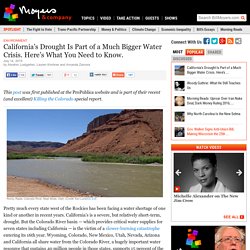
Rocky Rapid, Colorado River, Near Moab, Utah. (Credit: Ken Lund/CC 2.0) Groundwater depletion in India worst in world: NASA. Groundwater is disappearing fast from the world and India is among the worst hit, shows data from NASA's Gravity Recovery and Climate Experiment (GRACE) satellites.

Among the world's largest groundwater basins, the Indus Basin aquifer of India and Pakistan, which is a source of fresh water for millions of people, is the second-most overstressed with no natural replenishment to offset usage, said two new studies led by the University of California - Irvine (UCI), using data from GRACE satellites. About a third of the Earth's largest groundwater basins are being rapidly depleted by human consumption, the studies said. Groundwater aquifers are typically located in soils or deeper rock layers beneath the Earth's surface. Map: Here's where the world is running out of groundwater. Some of the world's most important farming regions rely on freshwater from large underground aquifers that have filled up slowly over thousands of years.
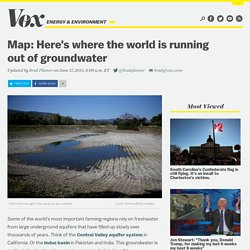
Think of the Central Valley aquifer system in California. Or the Indus basin in Pakistan and India. This groundwater is particularly valuable when rain is scarce or during droughts. But that groundwater won't necessarily last forever. New data from NASA's Grace satellites suggests that 13 of the world's 37 biggest aquifers are being seriously depleted by irrigation and other uses much faster than they can be recharged by rain or runoff. The map below gives an overview. Water: Infographic. Nature Is Speaking – Penélope Cruz is Water.
Drought in Eastern Mediterranean Worst in 900 Years. More than half the world suffers from 'severe' water scarcity, scientists say. Alarming new research has found that 4 billion people around the globe - including close to 2 billion in India and China - live in conditions of extreme water scarcity at least one month during the year.
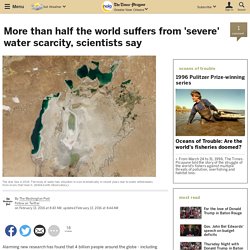
Half a billion, meanwhile, experience it throughout the entire year. The new study, by Mesfin Mekonnen and Arjen Hoekstra of the University of Twente in the Netherlands, uses a high resolution global model to examine the availability of "blue water" - both surface and underground freshwater - in comparison with the demand for it from agriculture, industry and human household needs. The model - which zoomed in on areas as small as 60 kilometers by 60 kilometers in size at the equator - also took into account climatic factors, ecological ones (how much water is needed to sustain a river ecosystem or lake) and other causes of depletion such as simple evaporation. Those prior studies had given totals of about 1.7 to 3.1 billion, rather than the current 4 billion. California drought over - groundwater still lower. FILE PHOTO - A visitor walks near the receding waters at Folsom Lake, which is 17 percent of its capacity, in Folsom Thomson Reuters LOS ANGELES (Reuters) - One of the worst droughts in California history has officially ended, Governor Jerry Brown declared on Friday, but not before it strained the state's farm economy and threatened water supplies for millions of residents.
Months of drenching storms and melting snowpack have replenished reservoirs, which began drying up in late 2011. That allowed Brown to lift most stipulations of an emergency order he implemented in January 2014, about two years after the conditions crossed the line into drought. Brown also said the need for conservation continued.
Officials will still require some long-term water-use limits imposed last year and are developing water preservation standards for urban agencies. California Says Nestle Lacks Permits To Extract Millions Of Gallons Of Water. An image from a report by the State Water Board shows the area of the headwaters of Strawberry Creek in the San Bernardino National Forest. The board says Nestle lacks the permits it needs to extract all of the water it's been taking from the area. California State Water Board hide caption toggle caption. The 11 cities most likely to run out of drinking water - like Cape Town.
Image copyright Getty Images Cape Town faces the unenviable situation of being the first major city in the modern era to run out of drinking water. However, the plight of the drought-hit South African city is just one extreme example of a problem that experts have long been warning about - water scarcity. Despite covering about 70% of the Earth's surface, water, especially drinking water, is not as plentiful as one might think.
Only 3% of it is fresh. Over one billion people lack access to water and another 2.7 billion find it scarce for at least one month of the year. According to UN-endorsed projections, global demand for fresh water will exceed supply by 40% in 2030, thanks to a combination of climate change, human action and population growth. It shouldn't be a surprise, then, that Cape Town is just the tip of the iceberg. 1. Water insecurity / supply. Water scarcity could affect 5 billion people by 2050. A new report claims that half of the world’s population may struggle to quench its thirst in the coming decades.
The news: UNESCO’s new World Water Development Report says that 3.6 billion people currently live in places that can suffer from water scarcity for at least one month of the year. It projects that the figure will rise to five billion—half of the world’s predicted 10 billion population—by 2050. The problem: More and more demands are being placed on the water cycle by industry, agriculture, and a growing population. At the same time, climate change is exacerbating the problem by causing extreme drought and floods, often making arid regions even drier—and we're not doing enough to solve that problem. The solution: Might not be entirely technologocial. Image credit: Jeremy Brooks | Flickr. The World’s Water Crisis Explained on World Water Day. “Day Zero,” when at least a million homes in the city of Cape Town, South Africa, will no longer have any running water, was originally scheduled for April. It was recently moved to July. The three-year long drought hasn’t ended, but severe water rationing—limiting people to a mere 13 gallons (50 litres) per person per day—has made a difference.
(To put this into perspective, an average U.S. citizen uses 100 gallons (375 liters) per day.) World Water Day 2018: Facts And Quotes To Share To Raise Awareness. Thursday is World Water Day, an annual celebration initiated by the United Nations to raise awareness about water scarcity and how to preserve and use it safely.
Drought Returns to Huge Swaths of U.S., Fueling Fears of a Thirsty Future. Residents line up in February to fill plastic water bottles and containers at a natural water spring on the site of a local brewery in Cape Town, South Africa. As a waterless Cape Town has become a potential reality, its story has sparked new concerns over the growing scarcity of the planet’s most basic resource. The New “Water Barons”: Wall Street Mega-Banks are Buying up the World’s Water. This article was first published on December 21, 2012 by Market Oracle and Global Research.